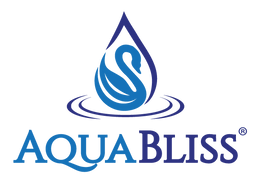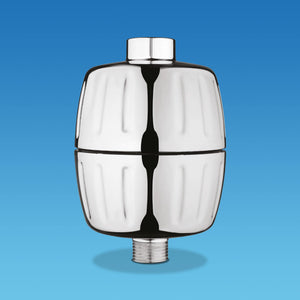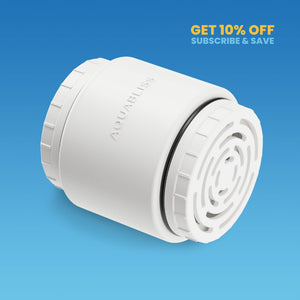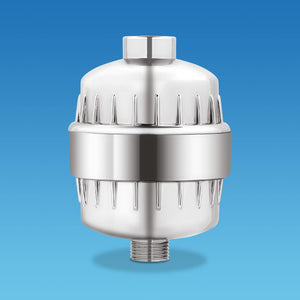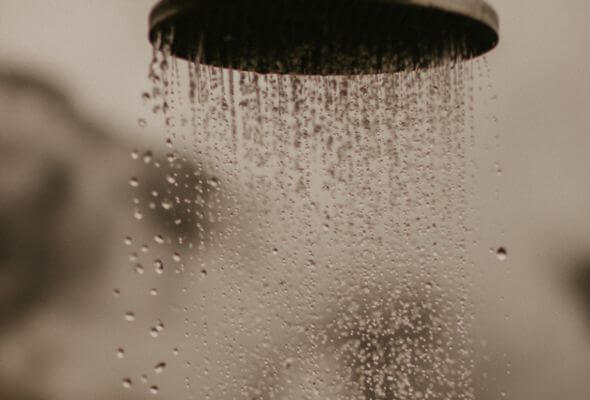Most tap water is considered safe to consume, but can you drink shower water? Even when shower water comes from the same source as your faucets, drinking shower water is not recommended.
Below, we take a look at the very real reasons to avoid it, what happens if you drink shower water, and how to improve your overall shower quality with an AquaBliss shower head filter.
Can You Drink Shower Water?
The shower water will often come from the same source as faucet water in your home, but it goes through a more precarious journey before it reaches you. Whether your shower water comes from a well in the backyard or the city water plant, there are still plenty of reasons not to drink from it.
Some people won’t drink unfiltered water, but tap water fans may not know shower water has an increased potential for contamination. Water and the treated city supply can have high levels of minerals, cleaning chemicals, and even debris from the plumbing system, but officials still consider it safe to drink.
On the other hand, shower water is stored in tanks, runs through dirty shower heads, and even comes from a different source than faucet water in some homes. These extra potential sources of contamination are the reason you should avoid drinking shower water, no matter where it comes from.
What Happens if You Drink Shower Water?
Drinking shower water won’t always lead to immediate illness, but contaminated water can cause mild to severe sickness, including diarrhea, vomiting, and even viral conditions.
If you or your family are elderly, immunocompromised, or otherwise physically vulnerable, drinking from the shower is definitely not a good idea.
Why Shower Water Isn’t Suitable for Drinking?
All water running through your pipes is exposed to a certain level of contamination and debris. Shower water goes through extra steps and is often left standing, vulnerable to the breeding of illness-causing bacteria.
Below, we explore some potential causes for contamination and some ways you can spot water with a problem that needs addressing.
1. Water in Old Pipes

Many homes still have older plumbing systems, with bathroom piping often left until last to replace. Old shower plumbing can develop leaks, introducing contaminants into the water and offering areas where mold, mildew, and bacteria can thrive.
If you spot wet patches in your walls, the scent of mildew without a clear source, or suddenly see mold springing up, you may have an undetected leak contaminating your water.
2. Water Heater
Wet and warm areas are a paradise for bacteria, and water heaters are no exception. Already a source of sediment and mineral deposit build-up, water that hangs around your water heater for any amount of time is at risk of picking up extra passengers.
3. Unpleasant Odors
Contaminants can hide in water, invisible to the naked eye. But sometimes, the iffy smell of shower water can give away the presence of bacteria lurking within. It can be a little hard to spot when you have heavily chlorinated and treated water, but shower water that smells foul could be heavily contaminated with bacteria.
4. Water Discoloration
Discolored shower water is alarming and can suddenly look strange for many reasons. Plumbing problems, maintenance at city plants, and high iron levels in the water can all create discoloration of your shower water.
As a shower streams over your body, its rain-like thin streams make it more difficult to see discoloration, so drinking it can lead to unknowingly ingesting contaminated water.
5. Storage Tank

Storage tanks are a convenient way to store more water on your property but require maintenance and can be a breeding ground for contamination of shower water. As water sits in storage, conditions can be ripe for contamination.
The warm, wet environment provides a spot for bacteria, mold, and mildew to thrive, potentially leading to health concerns. Correctly and regularly maintaining your storage tank is a crucial part of keeping your water as healthy as possible.
Even when tanks are regularly maintained, it is still not advisable to drink shower water, as contamination can begin at any time.
6. Dirty Shower Heads
When you shower, water pushes through the shower head into multiple small streams, creating the relaxing cascading effect we love. When you turn off the shower, there is always some water left behind in the shower head.
You can often see your shower dripping for a time after you turn it off. This left-over water sits in the shower, becoming a potential hotbed for mold, mildew, and bacteria growth.
Regularly cleaning your shower head and using a quality filter can lessen the overgrowth of bacteria and reduce your skin’s exposure to irritants. Helpful for your skin health, you should still avoid drinking shower water, even with a filter.
7. Chlorine Presence
Water treatment facilities use chlorine to eliminate bacteria within the water system. Depending on your climate, city water pipe system, and recent testing results, different amounts of chlorine will be added.
Higher levels of chlorine in your water can change your shower experience. The vapor from this cleaning treatment is inhaled with shower steam, leading to potential respiratory irritation.
8. Filtration Systems

Address common issues with filtration systems, such as limited effectiveness against certain contaminants and the need for regular maintenance. If your home uses a water supply from a well, you might also use a filtration system to reduce debris, lower mineral deposit levels, and improve overall quality.
Robust filtration is very effective, but it still cannot remove some dangerous contaminants like bacteria. Sophisticated filtration systems also require regular maintenance.
When a system is not well-maintained, additional contamination can enter the shower water supply from your well.
Is It Safe to Drink Filtered or Softened Shower Water?
Filtering your shower water reduces harmful chemicals, mineral deposits, and some contaminants, but bacteria and other pathogens picked up along the way can still make it through the shower head.
Using a high-quality shower filter can make your water healthier, but drinking shower water is still not advised.
Enhancing Shower Water Quality with Showerhead Filters
A shower filter may not remove every contaminant from your water but supports the overall health of your family.
Consider fitting a simple and affordable shower filter like AquaBliss to change your shower experience with:
- Lower chlorine levels to protect your lungs, skin, and overall health
- Reduced iron deposits to prevent shower and bathtub discoloration
- Less mineral build-up, making your bathroom easier to clean
- Fewer harsh water deposits to stop skin irritation, dandruff, and damage to your hair
Final Thoughts
Drinking shower water is not recommended, as contamination from plumbing, tanks, and dirty shower heads can easily deliver bacteria-laden water. While the risks of serious illness are low, you should always use caution and ensure that immunocompromised family members know the risks.
A shower head filter will not remove bacteria, mold, and mildew, but it can go a long way to clean up your water. By reducing mineral deposits, chlorine levels, and other harsh water treatment chemicals, AquaBliss changes your entire shower experience.
Creating bubble-rich lather and soft rinsing for your skin, why not enjoy the most healthy and luxurious shower you can?

